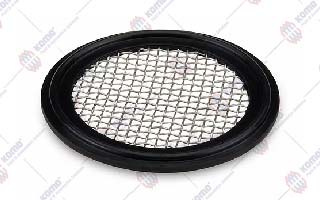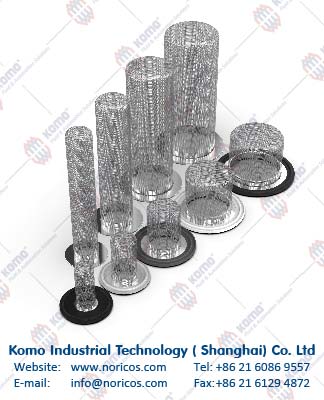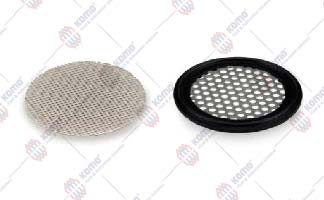Retentions of standard screens are calculated according to international standards by means of perfectly round spheres. Our screens are only one layer and therefore they cannot be considered the same as conventional filters. Each screen gasket has a high-performance gasket made out of one of the validated compounds that we use for our standard Sanitary Gaskets range.
Screens are designated in mesh sizes such as mesh 20, 40, 100, and so on (Photo 1). 20 Mesh means 20 wires per inch, in both directions, the opening is therefore square. The higher the mesh number the smaller the hole size. The smallest size has a 10μm retention: 200 x 1150 wires.
Moreover, it is important to take into account the physical shape of the particles anticipated in your system. It is surely not an exact science
Applications
Pump protection
In practice, a typical application for a screen is pump protection. Think about what can be pumped through a new build piping system in a startup. Some pumps might not survive this first run.
Filling needles
Another application is a fine filter in front of filling needles in the final stage of a filling line. The fine filter is applied to prevent an isolated loose particle from ending up in a vial or a bag.
WFI systems
Screens can also be used at the point of use in WFI systems. It is fascinating to know that the pressure drop over a 1,5 screen with 100 mesh is only 90 mbar at 6m³/h. Frequent cleaning of the screen is required. Eventually, details information please contact wiht Komo company.
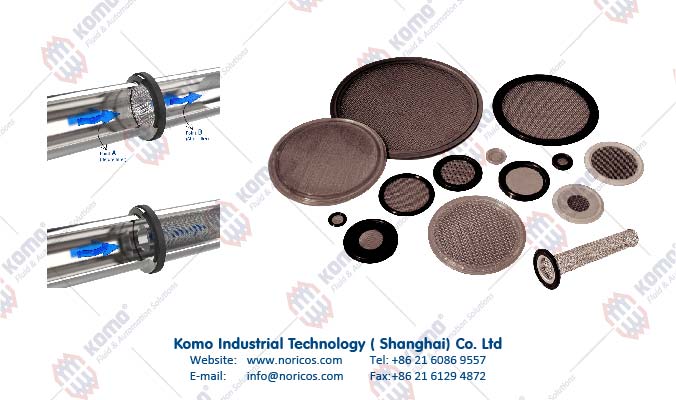
Screen Gasket molded our standard
In many upstream and downstream processes, it is sometimes required to do an inline or in situ filtration step. It is usually meant to capture isolated particles created by moving parts in the system. Deterioration of valve membranes, pumps or gaskets can generate these kinds of particles.
In a start-up phase, it can be used to protect pumps from large items that accidentally fall in the system and are flushed through causing major damage.
Filling needles can be equipped with a fine filter down to 10μm to capture anything that should not be there before the vial is sealed.
Material
The materials that we use for our gaskets are carefully selected and meet current requirements for pharmaceutical use.
Popular gasket materials are:
★ EPDM
★ BUNA-N ( NBR)
★ Platinum Silicone
★ FKM
★ PTFE
★ PTFE Envelope elastomer (EPDM, FKM etc.)
★ Tri-Bond® (PTFE bonded to elastomer)
★ Steam-Flon® (PTFE with stainless steel powder)
Standards
We provide sanitary gaskets in all standards such as:
★ DIN32676 (Series A)
★ ISO1127 (DIN32676 Series B)
★ ASME BPE (DIN32676 Series C)
★ ASME BPE Category I & II ( lipped & unlipped)
★ ISO2852
★ SMS3019
★ BS4285
★ and etc.
Approval Certification
★ FDA CFR 177.1550
★ FDA CFR 177.2600
★ USP Class VI-121°C testing Part 88
★ USP testing Part 87
★ USP 41 Cytotoxicity <87>
★ USP testing Part 661
★ USP testing Part 381
★ EP 3.1.9 A European Pharmacopoeia
★ EC1935/2004 (EC10/2011)
★ EMEA/410/01 (TSE/BSE free)
★ ADIF
★ ISO 10993-5
★ Cytotoxicity Criteria
Double Mesh Screen Gaskets
Fine mesh screens are fragile and could break away when solid material builds up . It is possible to use two screens on top of each other, one for support and one for the final filtration. When using double mesh screens it is important to place them in the correct orientation towards the flow direction. Reversed in process conditions could lead to failure of the fine mesh by braking off.
When entering the area of finer mesh sizes that a better solution is we recommend the use of Sintered mesh screens. The screen is build up with a supporting screen and a fine mesh screen on top. These are "welded" together and cannot be separated. This Double mesh product provides better pressure resistance and is suitable for backwashing cycles.
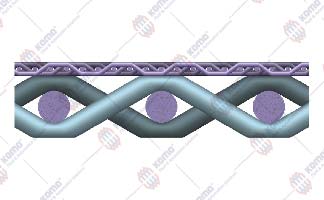
Double mesh screen sintered
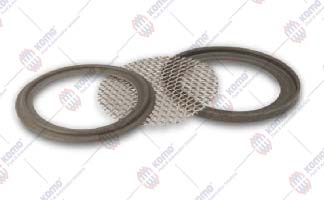
The double mesh sintered screens cannot be moulded in elastomers.

Flow direction double mesh sintered screen
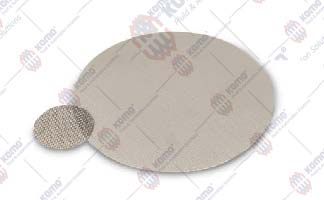
Sock Screen Gaskets
Sock screens are designed to take up a large amount of soil that it offer a greater soil collection capacity than standard flat screens. Flat screens will finally block when too much soil is accumulated. There is also a potential chance that the flat screen can break. Sock screens can take 8 to 10 times more soil, They are available in 150 mm (6") and 50 mm (2") lengths. If the capacity of a standard flat in situ filters is not sufficient then the Sock Screen is a good alternative, therefore it be used in processes where high particle collection is expected.
Our sock screens are available in 50 and 150 mm lengths and can be made in a wide range of mesh sizes.
Standard mesh sizes for sock screens are 10, 20, 40, 60, 100, 150, 200, 250 and 325 mesh.
Other mesh sizes are on request.
Perforated Screen Gaskets
Perforated screens are basically stainless plates with specific hole sizes. The hole size variation is limited to a couple of perforation sizes. The holes are relatively large and the plates are used to capture large debris. This is possible because they are very strong (±1,00 mm thick).
The perforated screens are supplied with so-called slit gaskets. A reason for this is that when the gasket is damaged, it can be replaced.
The perforated disc and screen can be used in combination with our Elastomeric slits gaskets and the Removable Steam-Flon® gaskets.
DIN 11864 screen
We have introduced a complete range of DIN11864 screens. The DIN11864 is becoming more popular in both the pharmaceutical and the food industries. The Tri-Clamp fitting has been around so long that all special components have become easily available. The DIN11864 is a relatively new fitting and therefore these special components are not readily available. They are available now at Komo because we made an effort to invest in these new components.
Approval Certification
★ FDA CFR 177.2600
★ USP Class VI-121°C
★ EC1935/2004 (EC10/2011)
★ TSE/BSE (ADIF) free (EME/410/01)
Material:
★ EPDM
★ FKM
★ Platinum Silicone
★ Other material on request
The DIN11864 is developed for three different pipe standards:
DIN11866 Series A piping (DIN, Reihe A)
DIN11866 Series B piping (ISO1127, Reihe B)
DIN11866 Series C piping (ASME BPE, Reihe C)
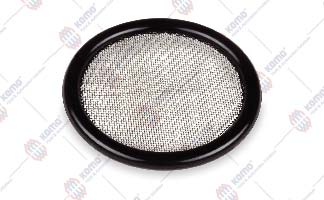
DIN 11864 screen
The Newest: Screen Gaskets With Tab
How useful would it be if you can see which screen gasket is mounted by looking only on the outside of your piping system? You do not have to disassemble anything and you do not have to memorize it. Our screens gaskets are meant to capture isolated particles created by moving parts in our piping system. On top of that, our engineering has developed screen gaskets with tabs. A tab is a helpful feature to visualize the presence of our screen gaskets in line and is easy to recognize from the outside.
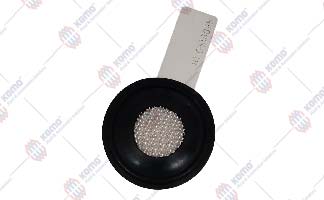
Screen gasket with tab
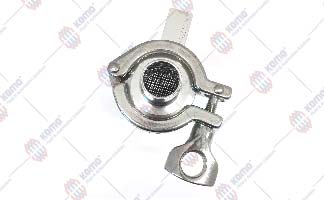
Mounted screen gasket with tab
As you can see in both photos, the mesh size and heat number screen material can be laser engraved on the tab. Our screens are available in various mesh sizes and compounds.


